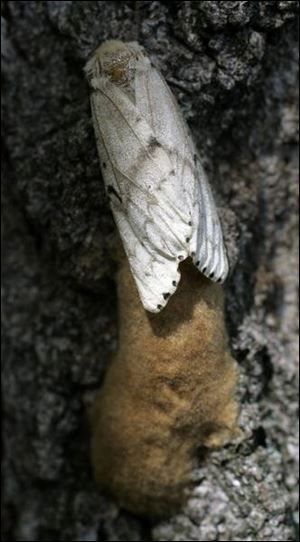
Infestation of pest is called one of worst in area since 1990s
6/6/2006
Gypsy moths live only for about 10 days as moths, but that is time enough to lay eggs for the next generation.
After initially thinking the Toledo area would get off easy with gypsy moths this summer, officials learned quite the opposite.
Phones were ringing off the hook yesterday at the Ohio State University's extension office at Toledo Botanical Garden with reports of the leaf-munching caterpillar damaging trees and plants in West Toledo, Sylvania Township, and South Toledo, as well as parts of Whitehouse and the Oak Openings region in southwest Lucas County.
"I've never seen so many caterpillars, ever," said Dave Crook of 4114 Wyndwood Dr. "They're everywhere - all over the house, all over the driveway."
He's one of about a dozen residents in the Westchester Woods subdivision who are pooling their money for an arborist to apply insecticides to kill the caterpillars. "Right now, there's a 50-50 chance they'll fall in your hair when you walk outside," Mr. Crook said.
Amy Stone, an OSU extension agent, said the infestation is one of the worst since the 1990s. Affected homeowners have until the end of June to do something about them, she said. The longer they wait, the bigger the caterpillars become - and the more damage that will be done.
Ms. Stone recommends hiring an arborist. Gypsy moths attack 500 species of trees and plants but have an affinity for oaks.
Insecticides need to get high up into the tree's canopy, so unless it's a small tree, Ms. Stone suggests people hire a professional to do the job.
"A typical homeowner isn't going to have the equipment they're going to need to have," she said.
The problem isn't limited to leaves. Once the caterpillar evolves into a moth, it becomes a heck of a pest. The moths only live an average of 10 days. But they mature at different times and create swarms, making outdoor patios unpleasant, if not unusable.
Gypsy moths can become so abundant that their frass, or excrement, can create quite a problem for people walking under infested trees.
"I've walked into infestations when it's sounded like it's raining," Ms. Stone said. Years ago, when the moths were prevalent in Sylvania, some residents felt compelled to put umbrellas over their heads even when they just stepped outside to get their mail, she said.
The only gypsy moths that fly are males. The females are releasing pheromones to attract the males, mate, and lay the next generation's eggs.
Do nothing and the moths will eventually be gone, probably by middle to late July.
Trees can die from two or three years of repeated damage to their foliage. But a first-year infestation resulting in the death of a tree is rare, except for those trees that have been stressed by other problems, Ms. Stone said.
Regardless what approach you take, Ms. Stone advises residents to keep doing what they're doing: calling her office at the first sign of infestation.
The information is needed to help build a case for aerial spraying by the Ohio Department of Agriculture in 2007. The deadline for such funding applications is Sept. 15. The spraying usually occurs the first or second week of May.
Two sites in Paulding County and one in Putnam County are the only ones in northwest Ohio funded for such treatment this year, state agriculture records show.
Contact Tom Henry at:
thenry@theblade.com
or 419-724-6079.